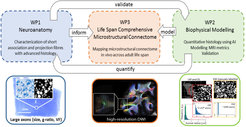The comprehensive microstructural human connectome (COMIC):
from long-range to short-association fibers – Priority Programme “Computational Connectomics” SPP 2041 of the German Research Foundation (DFG)
Consortium
In this DFG funded project in the frame of the Priority Programme SPP2041 PIs and their teams from three different institutions (MPI-CBS, UKE, PFI) will work closely together on developing models, methods and techniques to create a better map of the human microstructural connectome from long-range to short-association fibers using in vivo and ex vivo MRI as well as histology.

Background
The human neocortex is organized in specialized regions integrated in synchronized networks connected by long- and short-range association fibres. The microstructural composition of the fibres optimizes the speed of communication within the physical metabolic limits. These connections, their microstructural properties (e.g. axon diameters and their myelination), and their interactions can be summarized as the microstructural connectome. Most current estimates of the human structural connectome are based on Diffusion-Weighted Magnetic Resonance Imaging (DWI) and suffer from incompleteness and method-related biases. Particularly, short association connections, playing a central role in small-world-like brain networks, are underrepresented. In the first funding period, we generated a human microstructural connectome by projecting microstructural information along the long-range fibres. However, it is problematic that the short cortico-cortical connections (including U-fibers) are underrepresented in current connectomes.
Goal
In this project, we will generate the most comprehensive human microstructural connectome across the adult life span by additionally including the short cortico-cortical fibres and their microstructural properties.
Methods
To this end, we will use a powerful multidisciplinary approach that is built on three pillars (Figure). The first pillar (WP1) investigates the microstructural composition, length, and shapes of short association fibers using advanced ex vivo histology with large-scale ultra-high-resolution imaging within two specific brain networks, the visual and the sensory-motor system. The second pillar (WP2) provides deep-learning tools that quantify microstructural information (e.g. distribution of axon diameters or axonal g-ratios) from large-scale ultra-high-resolution microscopy images (WP1). Moreover, it devises biophysical models (WP2) that are validated and informed by the aforementioned quantified histological microstructural information. Finally, it implements robust methods for tractography of short- and long-range fibres based on in vivo and ex vivo MRI. The last pillar (WP3) uses the newly developed methods to robustly estimate microstructural information across short- and long-range fibres from in vivo MRI within a cohort of healthy subjects spanning the entire adult life span.
Impact
This will generate a comprehensive life span connectome that, for the first time, incorporates both short cortico-cortical and long-range connections together with their microstructural information. Additionally, intra-cortical microstructural measures will be derived and integrated based on established cortical myelin and iron mapping approaches.
Principal investigators of the COMIC project:
Evgeniya Kirilina (WP2): kirilina@cbs.mpg.de
Siawoosh Mohammadi (WP2): s.mohammadi@uke.de
Markus Morawski (WP1): Markus.Morawski@medizin.uni-leipzig.de
Nikolaus Weiskopf (WP3): weiskopf@cbs.mpg.de
